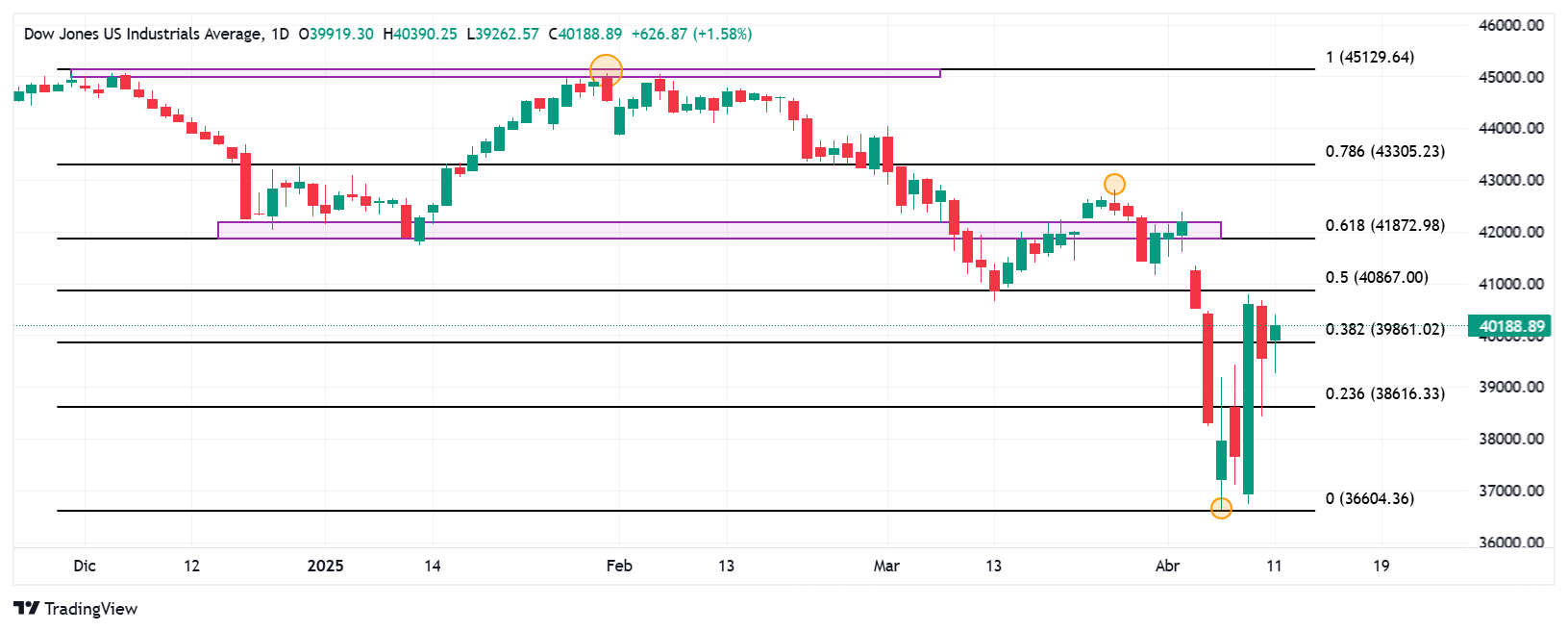- The Dow Jones rises 1.58% today, operating at the time of writing at 40,188.
- The Nasdaq 100 rebounds 1.80% daily, driven by Strategy Incorporated (MSTR).
- The S&P 500 wins 1.72% in the last day of the week, encouraged by a possible commercial agreement between the United States and China.
- The United States production price index is 2.7% in March, compared to 3.3% expected by consensus.
- The feeling of the consumer of the University of Michigan decreases to 50.8 points in April, disappointing market projections.
The Dow Jones marked a daily minimum in 39,262, finding buyers who promoted the index to a maximum of the day at 40,390.
The Dow Jones industrial average began negotiations at 39,919, while the Nasdaq 100 technological index began operating in 18,492. The S&P 500 opened in 5.315, maintaining the short -term bass perspective.
Apple and JP Morgan Chase drive Dow Jones to a positive zone
The Dow Jones index wins 1.58% today, currently quoting over 40,188.
Apple’s titles (AAPL) rebound 4.06% daily, reaching maximum of April 9 in 199.54 $.
In the same tonic, the values of JP Morgan (JPM) have a 4% gain in the last day of the week, reaching maximums not seen since April 3 at 238.58 $.
In this scenario, Dow Jones wins 626 points in the day, consolidating within the operational range of Thursday’s session at 40,188.
The Nasdaq 100 is quote updated by Strategy Incorporated and Fastenal Company
The Nasdaq 100 technological index rises 1.80% daily, reaching a maximum of the day in 18,725.
The actions of Fastenal Company (FAST) rebound 6.40% in the last day of the week, reaching maximums not seen since March 10 in 81.31 $.
Fast announced its quarterly report obtaining income for 1.96 billion dollars four compared to the 1.95 billion dollars provided by the consensus. In the same way, it achieved an earlier for $ 0.52, complying with market projections.
On the other hand, Strategy Incorporated (MSTR) values with a 10.15% gain today, reaching April 2 at 304.15 $, leading profits in the technological index.
The Nasdaq 100 wins 329 points on Friday, consolidating within the operational range of the previous session at 18,661.
The S&P 500 concludes the week on positive terrain in tune with the main stock market indices
The production price index rose 2.7% annualized in March, below the 3.3% expected and 3.2% observed in February.
At the same time, the feeling of the consumer of the University of Michigan presented a decrease at 50.8 points in April, disappointing the market projections of 54.5 points, being below the 57 registered in March.
Karoline Leavitt, White House Press Secretary, announced that Donald Trump projects to achieve a commercial agreement with China in the short term. In this context, the S&P 500 wins 1.72% today, staying within the range of the April 10 session in 5,354.
Technical Analysis of Dow Jones
The Dow Jones reacted down from a short -term resistance given by the maximum of March 26 in 42,820. The next important resistance is observed in 45,068, maximum of January 31. Down, the key support zone is located at 36,614, pivot point of April 7.
Dow Jones daily graphics

Dow Jones Faqs
The Dow Jones Industrial Avenge, one of the oldest stock market indexes in the world, consists of the 30 most negotiated values in the United States. The index is weighted by the price instead of capitalization. It is calculated by adding the prices of the values that compose it and dividing them by a factor, currently 0.152. The index was founded by Charles Dow, also founder of the Wall Street Journal. In recent years it has been criticized for not being sufficiently representative, since it only follows 30 companies, unlike broader rates such as S&P 500.
There are many factors that promote the Dow Jones Industrial Average (DJIA) index. The main one is the added performance of the companies that compose it, revealed in the quarterly reports of business benefits. The American and world macroeconomic data also contribute, since they influence investor confidence. The level of interest rates, set by the Federal Reserve (FED), also influences the DJia, since it affects the cost of credit, on which many companies depend largely. Therefore, inflation can be a determining factor, as well as other parameters that influence the decisions of the Federal Reserve.
Dow’s theory is a method to identify the main trend of the stock market developed by Charles Dow. A key step is to compare the direction of the Dow Jones Industrial Avenge (DJIA) and the Dow Jones Transportation Average (DJTA) and just follow the trends in which both move in the same direction. The volume is a confirmation criterion. The theory uses elements of maximum and minimum analysis. Dow’s theory raises three phases of the trend: accumulation, when intelligent money begins to buy or sell; Public participation, when the general public joins the trend; and distribution, when intelligent money abandons the trend.
There are several ways to operate with the DJ. One of them is to use ETF that allow investors to negotiate the DJ as a single value, instead of having to buy shares of the 30 companies that compose it. An outstanding example is the SPDR Dow Jones Industrial Avenge ETF (day). Future contracts on the DJ allow the specular operators about the future value of the index and the options provide the right, but not the obligation, to buy or sell the index at a predetermined price in the future. Investment funds allow investors to buy a part of a diversified portfolio of DJ values, which provides exposure to global index.
Source: Fx Street
I am Joshua Winder, a senior-level journalist and editor at World Stock Market. I specialize in covering news related to the stock market and economic trends. With more than 8 years of experience in this field, I have become an expert in financial reporting.







